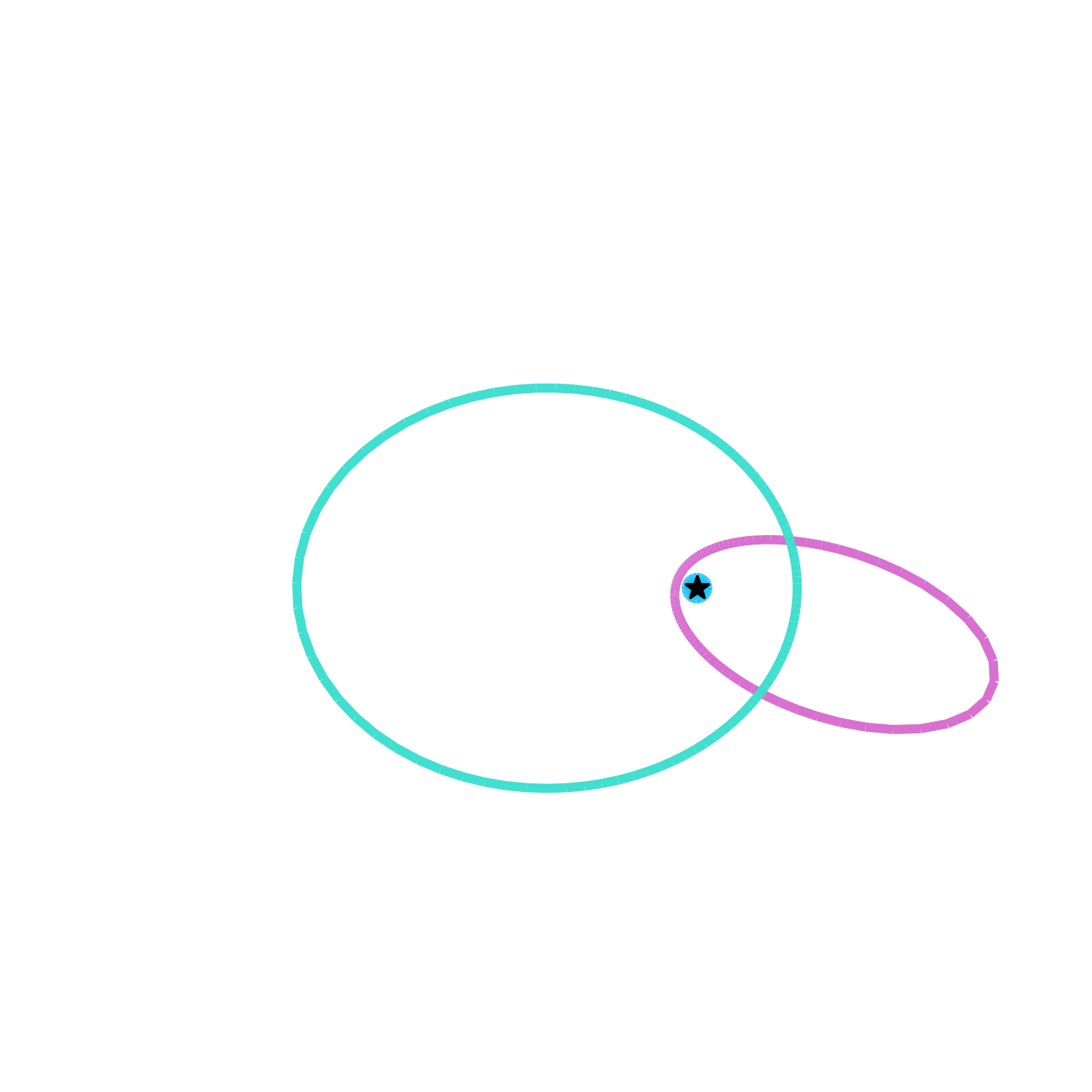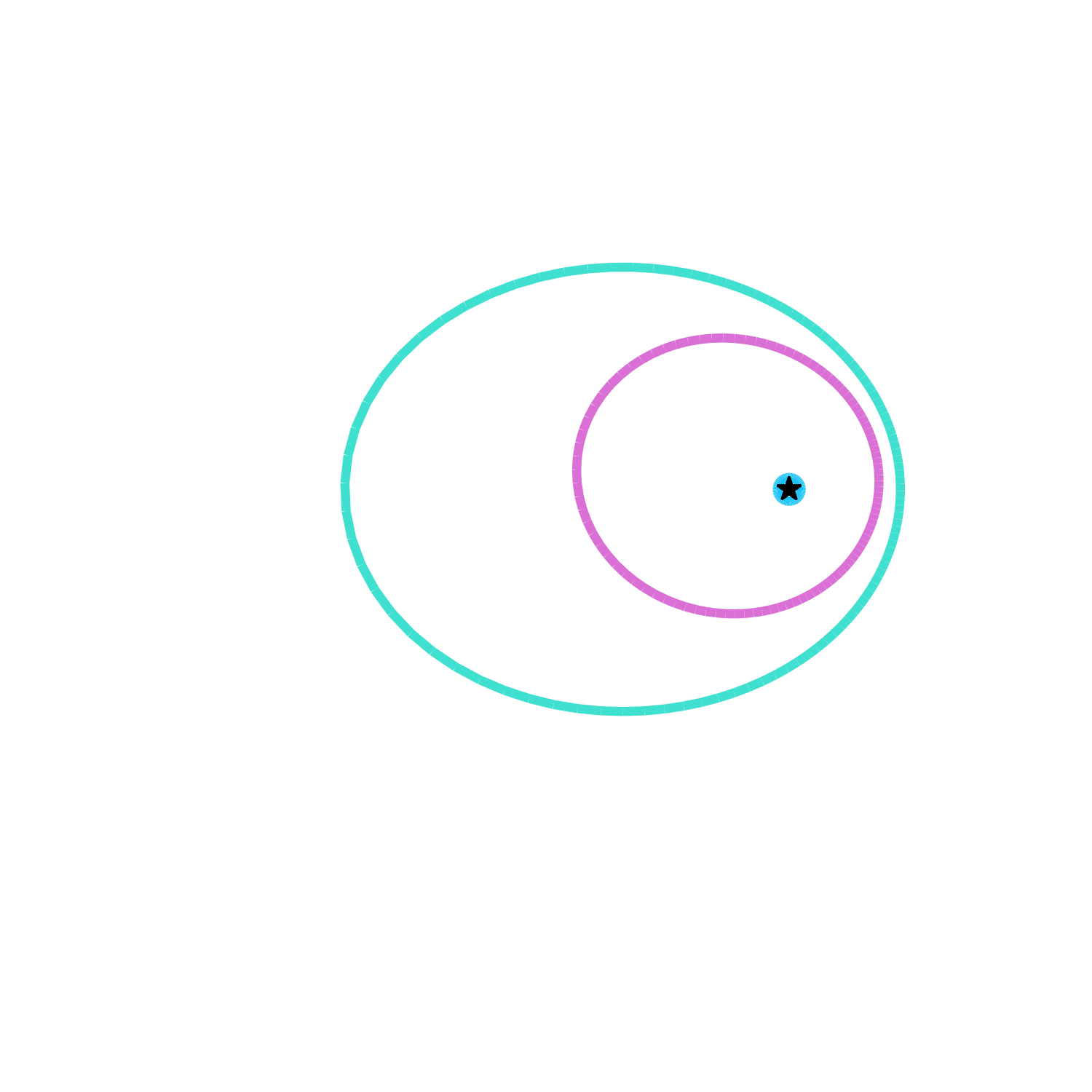Hi, everyone! I’m Tali, an undergrad at the University of Michigan. Last summer, I worked on a Planet Nine project with Konstantin and Mike, and although we didn’t find Planet Nine (yet!), we did look further into the stability of objects in the presence of Planet Nine. Turns out, not everything is stable!

Now, the anti-aligned population is not the only one we looked at. Planet Nine carves out an aligned cluster of objects as well, which experience librations in longitude of perihelion, but this time, inside the orbit of Planet Nine:


In his last post, Konstantin explained that the main cluster of anti-aligned objects is able to remain stable due to mean motion resonances with Planet Nine. Their orbits always cross Planet Nine’s orbit, but such resonances allow the objects to avoid collisions. Here’s an example of what the dynamics looks like: the green orbit is Planet Nine, and pink orbit is an anti-aligned Kuiper belt object. The little blue circle is Neptune’s orbit, and the star is the Sun (not to scale).
What we see here is that the anti-aligned object experiences librations (=bounded oscillations) in the direction its orbit points (the longitude of perihelion). Meanwhile, Planet Nine’s orbit slowly precesses and changes direction as well.
BUT, it turns out that being in resonance with Planet Nine is not enough for stability. That’s because Neptune is still in the picture. Let’s look back at the animation above. Notice that as the pink orbits wags back and forth, its perihelion distance (=the shortest distance from the orbit to the Sun) changes. The pink orbit stretches (and hugs Neptune’s orbit) and then circularizes (and detaches from Neptune). The wider the “wagging the tail” oscillations are, the more pronounced the in and out behavior becomes. If the object librates with too large of an amplitude, it comes suuuuuper close to Neptune. And when that happens, it either gets ejected from the solar system or its dynamics changes entirely, and its behavior is no longer relevant to Planet Nine.
SO, the stability of the anti-aligned objects can be summarized by the two gifs below. When the longitude of perihelion libration (tail-wagging) is mild, our object experiences small changes in perihelion distance, and thus remains at a safe distance from the inner solar system. But, if the librations become too wide (and too wild), the object goes unstable, thanks to Neptune.
| STABLE LIBRATIONS |
| UNSTABLE BEHAVIOUR |
Now, the anti-aligned population is not the only one we looked at. Planet Nine carves out an aligned cluster of objects as well, which experience librations in longitude of perihelion, but this time, inside the orbit of Planet Nine:
As you can see this object is in the perfect stable location - it stays far away from Neptune (blue) AND doesn’t cross Planet Nine’s orbit, and just quietly librates in longitude of perihelion. This object is all set for life. Nothing will make it budge from this configuration.
BUT, there are objects that seem to be aligned at first, but suffer because their libration amplitudes are too large. Here’s an example of such an object:
In the animation above, the orbit spins too far and crosses Planet Nine’s orbit. This is not good for two reasons: (i) Planet Nine starts having collisions with this object and knocking it about, and, (ii) UNLESS the object is in a resonance with Planet Nine, it gets swept by Planet Nine into the Neptune scattering region. If you look at the animation carefully after the pink orbit crosses the green orbit, you’ll see that the perihelion distance of the object is slowwwly decreasing. When it gets small enough - when the object starts interacting strongly with Neptune - we get the same output as for the unstable anti-aligned objects (i.e. instability and a crazy jumping dog.)
So, what’s the bottom line? Not all anti-aligned objects are stable! And not all aligned objects are stable. And it all depends on their perihelion distance, which is closely tied with their librations in longitude of perihelion.
Moreover, it turns out that what kind of objects we find surviving through the end of our simulations depends on the initial conditions we put in. What do I mean by initial conditions? Well, for example, we expect that different scenarios of Planet Nine’s formation would have affected the initial configuration of the Kuiper belt in different ways. So, suppose we start with two different initial conditions: a “narrow” Kuiper belt (objects initially within a narrow interval of perihelion distances) and a more widely spread “broad” Kuiper belt. And now we integrate these populations forward, in the presence of Planet Nine, in two separate simulations. Do these populations end up creating the same Kuiper belt?
In our recently accepted paper, we find that they don’t! In fact, the stable aligned population discussed above is completely missing from the “narrow” Kuiper belt. So, as the astronomy community continues to find more and more of these distant Kuiper belt objects, we might be able to start to tell which initial Kuiper belt we started with, and maybe how Planet Nine formed…
Read our paper here to find out more about Planet Nine, initial conditions, and stability!